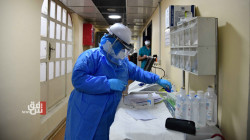Scientist Who First Sequenced Omicron Worried by Speed of Change

Shafaq News / The speed at which the omicron variant appears to have accumulated its unusual pattern of mutations is a concern, according to Sikhulile Moyo, the scientist who first detected the new strain that has quickly spread across the world.
The velocity of the mutations also raises questions about how the variant evolved and adds to the puzzle of how transmissible the variant may be.
Moyo, director for the Botswana Harvard HIV Reference Laboratory and a research fellow at Harvard T.H. Chan School of Public Health, said in a briefing on Friday that viruses don’t accumulate mutations in a single step. Given the global lack of adequate sequencing of the coronavirus, it’s very hard to get a good grasp of how early the omicron variant developed.
“We are still trying to understand how so many mutations arose for omicron in a short space of time,” he said. “If you look at the previous lineages, if you look at alpha, if you look at beta, you can see that the mutations accumulated over time.”
One of the theories is that this strain developed in an immuno-compromised person that harbored the virus for much longer than normal. Still, Moyo cautioned that there is no evidence for this. Another hypothesis being looked into is whether it could have been transferred from people into an animal host, adapted to that host relatively quickly and then moved back into humans.
When Moyo first sequenced the sample, taken on Nov. 11 from foreign diplomats who had traveled together to Botswana, the variant it most closely resembled was B.1.1.263. That variant is known as the U.A.E lineage and was first detected in early April 2020.
When he looked more closely at B.1.1.263 he saw that strain had less mutations and ruled out what he was seeing as being the same. After asking for more information from Botswana’s health department about the people from whom the positive samples had been taken, Moyo and his team deposited their findings into an international database on Nov. 23. A few hours later, a separate group in South Africa reported similar findings, followed by another group in Hong Kong that deposited a partial genome.
With omicron’s sheer number of changes, Moyo initially thought this would be a weak virus, he said. Instead, it seemed to be able to replicate quickly and evade parts of the immune system, causing a higher risk of reinfection.
Source: Bloomberg





